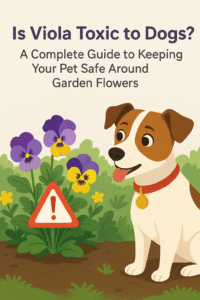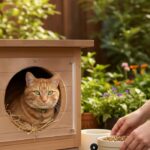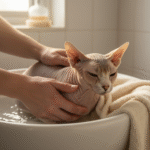Worried about your dog eating garden flowers? Find out is viola toxic to dogs and learn the critical difference between non-toxic species and treated ornamental varieties. Protect your pet with our essential safety guide.
The Popularity of Violas and Pet Safety Concerns
Violas, including the charming violets and the cheerful pansies, are staples in gardens and window boxes around the world. Their vibrant colors and relatively low maintenance make them a favorite for adding splashes of beauty from early spring well into the summer. However, for every proud dog owner, the beauty of a garden flower is instantly overshadowed by a single, pressing concern: Is this plant safe for my canine companion? The question of “is viola toxic to dogs” is one that frequently crosses the minds of pet parents and gardeners alike.
The reality of plant toxicity is often nuanced. It’s rarely a simple “yes” or “no.” When it comes to the Viola genus, the answer generally leans toward safety, but there are critical caveats that every dog owner must understand to ensure their pet remains happy and healthy. Understanding the specific species, recognizing the subtle signs of ingestion, and being aware of external factors like pesticides are all essential parts of responsible pet ownership in a garden setting. This comprehensive guide breaks down the science and provides actionable steps to keep your dog safe around these beloved bloomers.
The General Rule: Most Viola Species Are Not Inherently Harmful
The good news for most pet owners is that the majority of common Viola species—the ones typically referred to as violets (Viola odorata) and pansies (Viola tricolor var. hortensis)—are generally considered non-toxic to dogs. This means that if your curious canine nibbles on a few leaves or petals during a garden patrol, the likelihood of a severe, life-threatening reaction is very low.
These common varieties do not contain high concentrations of the truly dangerous toxins found in other common garden plants. They are often classified as non-toxic by major veterinary and poison control organizations. However, “non-toxic” does not necessarily mean “food.” While the plant itself may not possess harmful chemical compounds, it is still plant matter that a dog’s digestive system is not designed to process in large amounts. The general lack of inherent toxicity is a relief, but it’s the starting point, not the end, of the safety discussion.
Understanding the Botanical Classification
To fully grasp the safety profile, one must appreciate the sheer diversity within the Viola genus. With hundreds of species and countless hybrids, the term “viola” covers a wide array of plants. The common non-toxic varieties are distinct from other, sometimes more dangerous, garden flora. It’s crucial not to confuse the generally safe Viola with other plants that share similar growth habits or flower appearance, but which carry severe toxicity risks. Proper plant identification is the first and most critical step in pet-safe gardening.
Potential Risks: When Violas Can Cause Problems
While the plant itself may be low-risk, there are specific circumstances and factors that can turn a harmless nibble into a trip to the veterinarian. Pet owners must be vigilant about these variables.
1. Mild Gastrointestinal Upset from Ingestion
Even non-toxic plants can cause mild stomach upset, especially if a dog consumes a significant quantity. The ingestion of large amounts of any non-food plant material can overwhelm a dog’s digestive system. The plant fibers and compounds, while not chemically toxic, are foreign to the dog’s stomach.
• Symptoms of mild toxicity include the quick onset of digestive discomfort. These are typically self-limiting and resolve once the plant material is passed.
• Vomiting: The dog’s body attempts to expel the undigested plant matter.
• Drooling (Hypersalivation): This can be a reaction to the taste or a precursor to vomiting.
• Diarrhea: The digestive system attempts to flush the plant material quickly.
2. The Danger of Treated Ornamental Varieties
The most significant caveat concerning the Viola genus relates to chemically treated plants. Gardeners and commercial nurseries often use potent substances to ensure vibrant blooms and pest-free foliage.
• Chemical Fertilizers or Pesticides: These substances are the real danger lurking in your flowerbed. Even if the plant itself is safe, the chemical residue on the leaves or in the soil can be highly toxic. Ingesting chemically treated flowers is far more hazardous than eating an untreated, wild viola.
• Pesticides and Herbicides: These compounds are specifically designed to kill and can pose a serious risk of poisoning.
• High-Concentration Fertilizers: While necessary for plant growth, direct ingestion of concentrated fertilizer pellets or granules can lead to severe stomach and intestinal irritation.
3. Species Identification and Hybrid Uncertainty
Due to extensive hybridization for ornamental purposes, determining the precise species a pet has ingested can be challenging. Some specific hybrids or treated ornamental varieties may contain saponins or other compounds in trace amounts that could potentially exacerbate stomach upset. Always identify the exact species before assuming it’s non-toxic. When dealing with an unknown garden variety, err on the side of caution.
Actionable Safety Strategies for Pet Owners
Responsible pet ownership involves preemptive action. By implementing a few simple strategies, you can minimize the chances of your dog encountering any toxicity risk from violas or other garden plants.
Prevention is Key: Securing the Garden
The best defense is an offense—preventing access to the plants in the first place.
• Physical Barriers: Use low fencing, raised beds, or decorative edging to create a physical barrier between your dog and the most attractive plants.
• Discouraging Behavior: Keep dogs from chewing or digging around garden plants to prevent accidental ingestion of leaves, flowers, or contaminated soil. A simple “leave it” command can be invaluable in the garden.
• Designated Pet Areas: Create a designated, pet-safe area for your dog to play, separate from the main flowerbeds.
Safe Chemical Storage and Use
Since chemicals are often the true source of danger, managing these products is paramount.
• Store gardening chemicals safely away from pets. Keep pesticides, herbicides, and fertilizers in sealed containers on high shelves or in locked sheds.
• Application Protocol: Follow label instructions meticulously for ‘re-entry intervals’—the time required after application before it is safe for pets or people to touch the treated area. Opt for organic, pet-friendly pest and weed control methods whenever possible.
• Watering: After applying liquid fertilizers, water the area thoroughly to ensure the chemicals are soaked into the soil and not left as residue on the leaves or ground surface.
What to Do If Your Dog Eats a Viola
Despite the best precautions, accidents can happen. Knowing how to react quickly and calmly is vital.
1. Assess the Situation
• Identify the Plant: Determine exactly which plant or part of the plant (flower, leaves, roots) the dog consumed.
• Estimate the Amount: Try to gauge roughly how much your dog ate. A tiny nibble is very different from consuming an entire plant.
• Look for Chemicals: Check the surrounding area for signs of spilled fertilizer, pesticide pellets, or recently sprayed leaves.
2. Monitor and Contact Professional Help
If your dog eats a large amount, monitor closely for signs of distress, including persistent vomiting, lethargy, or drooling.
• When in doubt, call your vet or animal poison control hotline for advice. This is the most crucial step. Never wait for severe symptoms to appear. A veterinarian can determine if the amount ingested warrants a visit or if at-home monitoring is sufficient. Be prepared to provide the plant’s name, the estimated amount eaten, and any symptoms you are observing.
• Do NOT Induce Vomiting unless specifically instructed to do so by a professional. In some cases, inducing vomiting can cause more harm.
Conclusion: Enjoying Your Garden Safely
The good news remains: most common Viola species are beautiful, charming, and pose minimal inherent toxicity risk to your dog. They can coexist happily in a pet-friendly garden. The true hazard lies in chemical treatments, large-volume ingestion, and poor plant identification.
By maintaining awareness of what is growing in your garden, storing chemicals responsibly, and taking quick action if an ingestion occurs, you empower yourself to be a responsible pet owner and a successful gardener. Enjoy the cheerful blooms of your violas with the peace of mind that comes from knowing you have taken every step to keep your beloved canine companion safe.
Frequently Asked Questions
1. Are pansies and violets the same thing when it comes to dog safety?
Yes, for practical purposes concerning dog safety, pansies (Viola tricolor var. hortensis) and violets (Viola odorata) are both part of the Viola genus and are generally considered non-toxic. However, like most non-toxic plants, eating large quantities can still lead to mild stomach upset, such as vomiting or diarrhea. It’s always best to discourage your dog from eating any garden plants.
2. What are the most common signs a dog has eaten too much viola?
The symptoms are typically related to mild gastrointestinal distress. Look for non-severe signs like intermittent vomiting, excessive drooling (hypersalivation), or a bout of loose stools or diarrhea. These symptoms usually resolve on their own once the plant material passes through the system. If symptoms are severe, persistent, or include lethargy, contact a vet immediately.
3. If a viola is non-toxic, why is there a concern about my dog eating it?
The main concern is not the plant’s inherent toxicity, but external factors. The biggest risks are chemical contaminants like pesticides, herbicides, or concentrated fertilizers that may be present on the leaves or in the soil surrounding the viola. Also, ingesting a very large amount of any non-food plant material can cause a blockage or severe, non-toxic stomach upset.
4. Are the roots or leaves of the viola plant more dangerous than the flowers?
Generally, no part of the common Viola species is considered severely toxic. However, the concentration of compounds that can cause stomach upset, such as saponins (in trace amounts), is sometimes highest in the roots or seeds. Regardless of the part, the primary danger remains the presence of chemical treatments applied to the plant or the soil.
5. When should I call a veterinarian if my dog has eaten a viola?
You should call your veterinarian immediately if you suspect your dog has eaten a plant that was recently treated with fertilizer or pesticide. You should also call if the dog is showing severe symptoms, such as continuous vomiting, extreme lethargy, tremors, or weakness, or if the mild symptoms of vomiting and diarrhea persist for more than a few hours. When in doubt, always make the call.











